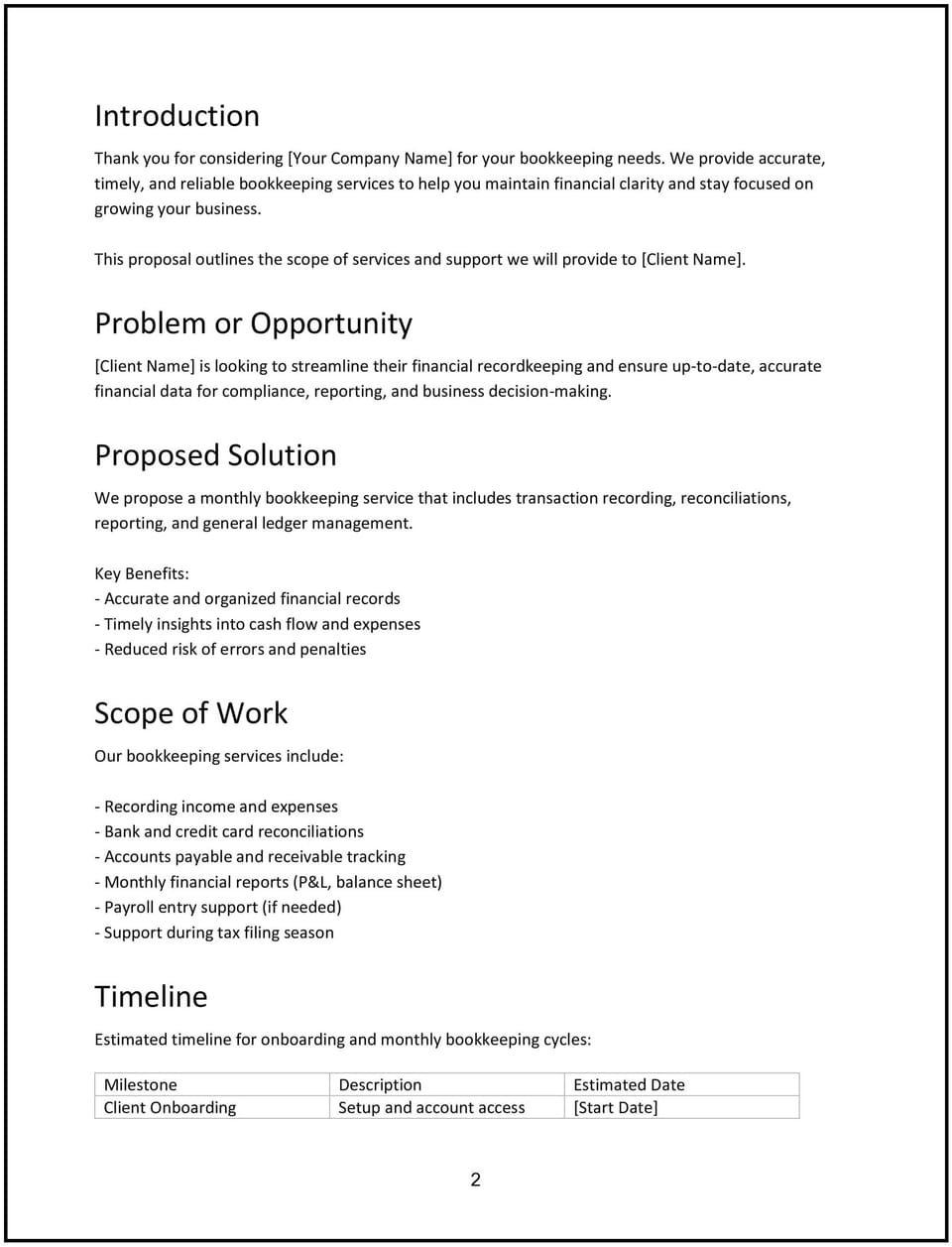Bookkeeping proposal: Free template

Customize this free bookkeeping proposal with Cobrief
Open this free bookkeeping proposal in Cobrief and start editing it instantly using AI. You can adjust the tone, structure, and content based on your bookkeeping process, the client’s industry, and their reporting needs. You can also use AI to review your draft — spot gaps, tighten language, and improve clarity before sending.
Once you're done, send, download, or save the proposal in one click — no formatting or setup required.
This template is fully customizable and built for real-world use — ideal for pitching monthly bookkeeping services, catch-up accounting, account reconciliation, or financial record maintenance. Whether you're a solo bookkeeper or part of a firm, this version gives you a structured head start and removes the guesswork.
What is a bookkeeping proposal?
A bookkeeping proposal outlines how you’ll support a client by organizing their financial records, tracking transactions, and maintaining accurate books. It usually includes the scope of services, tools used, reporting timelines, and pricing.
This type of proposal is essential for establishing trust and clarity, especially for small businesses, startups, or growing teams without internal finance staff.
A strong bookkeeping proposal helps you:
- Clearly define your deliverables and service frequency.
- Communicate your systems and data workflows.
- Build client confidence in your accuracy and reliability.
- Align on costs, expectations, and timelines.
Why use Cobrief to edit your proposal
Cobrief helps you write, refine, and share polished proposals — with built-in AI to support every part of the process.
- Edit the proposal directly in your browser: No formatting or template setup required
- Rewrite sections with AI: Clarify, simplify, or adjust your language instantly
- Run a one-click AI review: Improve structure, catch vague sections, and tighten your copy
- Apply AI suggestions instantly: Accept individual edits or apply all changes at once
- Share or export instantly: Send the proposal directly from Cobrief or download a PDF or DOCX file
Send smarter, clearer proposals — faster.
When to use this proposal
Use this bookkeeping proposal for:
- Offering monthly or quarterly bookkeeping support.
- Providing catch-up or clean-up bookkeeping.
- Supporting startups with ongoing financial record-keeping.
- Preparing books for tax season or external reporting.
- Responding to RFPs for outsourced bookkeeping.
It works well for both project-based and ongoing client relationships.
What to include in a bookkeeping proposal
Each section helps the client understand your workflow, what you’ll deliver, and how it benefits them:
- Executive summary: Outline the client’s need for accurate financial records and how your bookkeeping support will help them stay organized, compliant, and stress-free.
- Scope of work: Define exactly what’s included — e.g., transaction categorization, bank and credit card reconciliations, accounts payable/receivable tracking, monthly financial reports, or QuickBooks/Xero management.
- Tools and process: Mention the software you use (e.g., QuickBooks, Xero, Wave) and how you’ll collect, process, and report financial data.
- Timeline: Set expectations around service frequency — e.g., weekly reconciliations, monthly closing, quarterly reports.
- Pricing: Present your fees — monthly retainer, hourly rate, or flat-fee packages. Clarify what’s included and any optional add-ons (e.g., catch-up services or invoicing support).
- Terms and conditions: Cover data access, confidentiality, payment schedule, and support hours.
- Next steps: End with a clear call to action — such as “Reply to confirm,” “Schedule a kickoff call,” or “Sign to proceed.”
How to write an effective bookkeeping proposal
This proposal should feel trustworthy, organized, and detail-oriented:
- Focus on peace of mind: Emphasize that your service helps clients stay financially organized and stress-free
- Be precise: List what’s included and what isn’t — vagueness leads to confusion later
- Share your process: Show how you work, when you deliver reports, and how you communicate
- Mention your tools: Clients appreciate clarity on the platforms and systems involved
- Format clearly: Use bullet points, short paragraphs, and structured headings
- End with a confident CTA: Help the client know exactly what to do next
Frequently asked questions (FAQs)
Can I reuse this proposal for different clients or industries?
Yes — just tailor the scope, pricing, and tools based on the client’s structure and needs.
Does this work for one-time clean-up bookkeeping projects?
Absolutely. You can adjust the timeline and deliverables for catch-up or one-off engagements.
Should I include a sample report or checklist?
Yes — it helps show what the client can expect and builds trust in your process.
Is this proposal legally binding?
No — this is a proposal. You can attach or link a service agreement or engagement letter if needed.
Can I export this proposal as a PDF or DOCX file?
Yes — after customizing, you can instantly download it in either format.
This article contains general legal information and does not contain legal advice. Cobrief is not a law firm or a substitute for an attorney or law firm. The law is complex and changes often. For legal advice, please ask a lawyer.